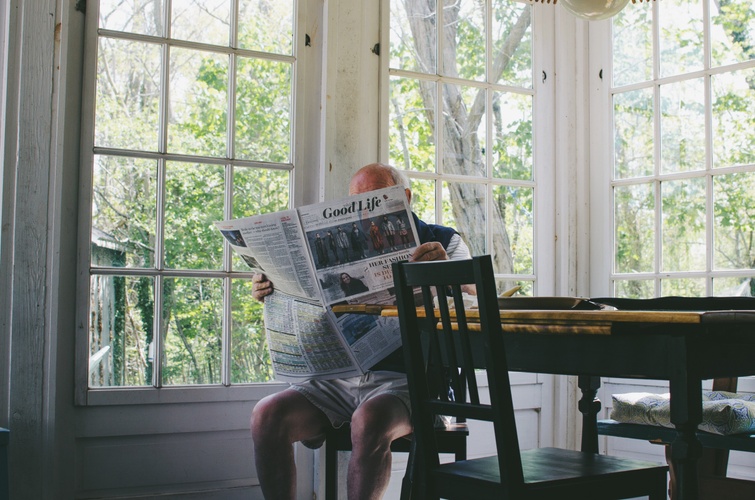
People choose their homes for a variety of different reasons – the view, the neighborhood, the backyard, the architecture. Few consider how well-suited the home is to prevent falls among the elderly. But there comes a time in most of our lives when the natural effects of aging challenge our balance, muscle tone, and reflexes. Falls are one of the biggest health threats for Americans age 65 or older, and the risk increases with age.
If you are considering downsizing or moving to a new place in retirement, do you know how to assess a home’s fall hazards? From the texture of the floors to layout of the kitchen cabinets, there are home features that can reduce the risk of injury from falls. The following checklist can help you evaluate your current home’s risk factors and guide your search for a new abode that will keep you safe well into your golden years.
The problem
Falls can happen at any age, but they are especially dangerous for people aged 65 and older. One in four seniors falls each year and the aftermath can be painful and costly, both financially and in terms of quality of life.
● Most falls only cause bruises and scrapes. However, one out of five falls causes a serious injury such as head trauma or a broken spine, hip, arm, leg, or pelvis.
● 47 percent of seniors who fall cannot get up without assistance.
● Falls that result in broken bones are twice as common in older women as in older men. However, men have a higher risk of dying after a fall.
● Broken hips are a leading cause of loss of independence. More than 95% of hip fractures are caused by falling – usually falling sideways.
● Falls result in more than 800,000 hospitalizations and 27,000 deaths each year.
● Every 11 seconds, an older adult is treated in the emergency room for a fall. Every 19 minutes, an older adult dies from a fall.
● When older people are hospitalized after a fall, their hospital stays are almost twice as long as those of older patients admitted for other reasons.
● Fall injuries are among the 20 most expensive medical conditions. The average hospital cost of a fall injury by an older adult is over $30,000 – and Medicare might not cover all of it.
● The medical cost for seniors’ falls was more than $50 billion in 2015 and has been increasing annually as the Baby Boomer generation gets older. It is expected to reach $67.7 billion a year by 2020.
More than 75% of falls happen in or near the home. Falls are most likely to happen in bedrooms, kitchens, or dining rooms, but bathrooms are where the most serious falls often occur. Stumbling during nighttime trips to the bathroom is a concern, but 80% of senior falls happen during the daytime while doing ordinary activities like getting out of bed, reaching for objects, rising from a chair, and climbing or descending stairs.
The most important thing to note is that the overwhelming majority of falls are preventable. By thoroughly reviewing your home’s features, identifying hazards, and making changes where needed, you can greatly reduce the chances of injury from a fall.
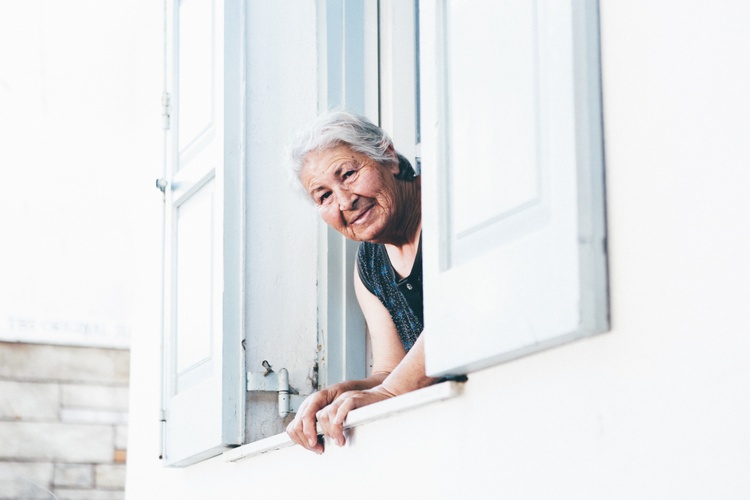
Recognizing hazards entering and exiting the home
Evaluating a home’s potential perils starts before you walk through the door. Single-level homes are safer for seniors than homes with two or more stories, but there are many more factors to consider than that. Take a look at each step between a car and the home’s entrance. Getting in and out of cars can be risky for seniors dealing with loss of balance, muscle weakness, or limited range of motion. It’s important to have a level surface and ample room to maneuver on either side of the vehicle. It’s also better for the mailbox to be near the door, if possible, eliminating extra trips to the end of the driveway or a communal mail center.
People returning from running errands might have bags or packages that can throw off their center of gravity, putting them at greater risk of a fall. Walkways should be paved and even. Handrails are helpful not only along steps, but also near doors. Many seniors benefit from having something to grip while they insert their key in the door. It can also be useful to have a waist-height surface to put parcels on while opening the door.
In an emergency, minutes can matter. Find out where the nearest hospital and fire rescue station are. The average response time for ambulances nationally is 7 minutes, but it can vary greatly depending on your location. Rural areas might be far from medical services. On the other hand, congested areas have hazards of their own. Heavy traffic and complicated intersections near the home can pose risks for elderly drivers and make it harder for first responders to arrive.
These are the first things to look for when assessing a home’s safety for seniors at risk of falling:
Home design
❏ Is the home on one level or does it have multiple stories?
❏ For apartments or condominiums, is there elevator access? Ideally, buildings should have at least two elevators, in case one is out of order.
❏ Is the mailbox near the door, or does the senior have to walk to retrieve letters and bills?
Location
❏ How far is the home from the nearest hospital and emergency responders?
❏ Are the roads leading to the home well-lit and well maintained?
❏ What are traffic patterns like near the home? Are there working signals and clear road markings?
Driveability & walkability
❏ Is there a driveway or parking space that is paved and even?
❏ How far does the homeowner have to walk from the car to the door?
❏ Are there sidewalks in front of the home and around the neighborhood?
❏ Are the sidewalks level and in good condition?
Front door
❏ Is the entry well lit?
❏ Is the entry likely to be slippery in wet or snowy weather?
❏ Are there steps leading to the front door? If so, is there a handrail?
❏ Is there something the homeowner can hold onto or brace against while inserting the key?
❏ Alternatively, is there a keyless entry system?
❏ Is there a surface to place parcels on while opening the door?
Stairs
❏ Does the stairway have adequate lighting?
❏ Do steps have slip-resistant surfaces?
❏ Do steps have a tread depth of at least 12 inches and a riser height of no more than 7.2 inches?
❏ Are there sturdy handrails that are at least 34 inches high and 1.5 inches in diameter?
❏ Is there contrast in color between the treads and risers so seniors with poor vision can see the transitions?

General home features that can reduce the risk of falls
Before you focus on specific rooms, there are some general home features to evaluate for fall risk. Flooring is one of the most important considerations because any unevenness underfoot can trigger a fall. Area rugs can develop lumps, have loose or curled edges, or shift if they are unsecured. Wood planks, tiles, and linoleum can sometimes lift or crack with age. The grout on tile floors can provide helpful traction, but deep grout lines can be a tripping hazard and can catch the wheels of a wheelchair. High-pile carpet can also be a tripping hazard. Some thresholds have pieces of molding where there is a transition between flooring types. These sorts of irregularities and uneven surfaces are a common cause of falls. However, at the other extreme, excessive smoothness can also pose a risk. Highly polished floors that don’t offer much traction can become slippery if something spills or if a senior wears slippers or leather-soled shoes. Ideally, floors should be level and have at least a bit of texture. Flooring that is shock absorbent can decrease the seriousness of injuries when falls do occur.
After flooring, lighting is one of the most important tools for preventing falls. Make sure the home has ample natural light during the day and enough illumination at night. Check the brightness of overhead lighting and lamps. If necessary, you can increase the wattage of bulbs. Check to see if light switches are the wide rocker-panel type or narrow traditional style. Arthritis and other conditions can make it hard for seniors to manipulate small switches. Illuminated rocker-panel switches are the best from a safety standpoint. The location of switches is also important. Seniors should be able to turn on the lights easily when entering a room or when getting up from bed. There should be switches at both ends of a hallway and at the top and bottom of any stairs. If switches aren’t conveniently located, consider adding remote-controlled or motion-activated controls. Look for electrical outlets in hallways and bathrooms where you can plug in night lights.
As you go through the home, notice if there are clear pathways from room to room. Doorways should be wide enough to accommodate a walker or wheelchair. The home should have enough storage space so there is no need to keep books, shoes, boxes, or other objects on the floor. You shouldn’t have to maneuver around furniture or obstacles to enter a room. Any electrical cords should be attached to the wall. Lever-style door handles are generally easier for seniors to operate than round knobs.
Here are general home features to assess for potential fall risk:
Flooring
❏ Are there area rugs that could create a trip hazard?
❏ Is flooring even, with no loose or bumpy areas?
❏ What is the texture of the floor like? Does it provide traction or is it smooth and potentially slippery?
❏ If there is tile, how deep are the grout lines?
❏ Does the floor currently get waxed or polished? That is not recommended in homes with seniors.
❏ If there is carpeting, is it low-pile (½ inch or less) with a firm pad underneath?
Doors and Doorways
❏ Are the doorways wide enough for a walker or wheelchair?
❏ Are thresholds smooth or are there pieces of molding on the floor?
❏ Are the door knobs lever-style (preferred) or are they round (which can be difficult for people with arthritis)?
Lighting
❏ Is the home light and bright during the day?
❏ Are there blinds or shades to prevent glare?
❏ Does the home have enough lamps and overhead lighting for night time?
❏ Do any light bulbs need to be replaced?
❏ Are light switches the wide rocker-panel type (preferred) or are they the small traditional style, which can be harder to manipulate?
❏ Is there a light switch near the bed?
❏ Are there light switches at both ends of hallways and at the top and bottom of stairs?
❏ Are there outlets where night lights can be plugged in?
Cords and Clutter
❏ Are outlets located appropriately, so there are no wires or cords on the floor?
❏ Does the home have enough storage space, so floors and walkways can be clear of clutter?
❏ Are the rooms big enough to accommodate furniture and leave ample walkways?
Safety features
❏ Does the home have smoke detectors in every room?
❏ Does it have a carbon monoxide detector on each floor, ideally five feet from the ground?
❏ Are there fire extinguishers in or near the kitchen and the garage?
❏ Is the water heater adjustable, so the water temperature can be capped at 120ºF or less?
❏ Are air conditioning filters easily accessible?
❏ Are the windows easy to open?
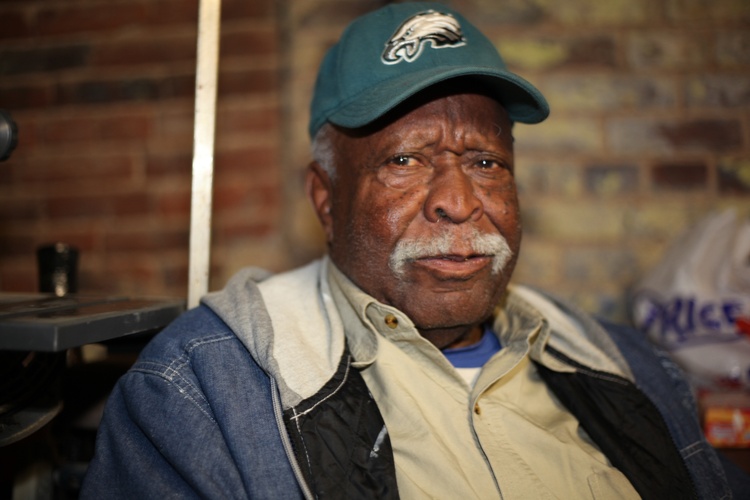
Room-by-room fall prevention checklist
One of the most important locations to focus on fall prevention is the bathroom. Hard surfaces like tile, porcelain, marble, glass, and metal abound in bathrooms – and those are just some of the perils. People often use them at night, when they’re less alert. Bathrooms get hot and steamy, which can be disorienting. In addition, people usually exit the shower naked and barefoot without their eyeglasses, hearing aids, or other assistive devices. Surfaces can be slick from not only water but mildew, soap residue, and lotions or hair conditioner. Cotton bath mats without rubber backings may shift and do more harm than good.
The key factors to consider in a bedroom are its proximity to the bathroom, the height and placement of the bed, and ensuring an environment that is quiet and conducive to sleep. Many seniors report difficulty falling and staying asleep, and being tired greatly increases the risk of falls. It is common for seniors to experience dizziness when going from lying to sitting and standing. Having a bed rail or transfer pole can help keep them steady while their bodies adjust. Getting up can be difficult, so beds shouldn’t be too high or too low. When sitting on the edge of the bed, the elder’s knees should form a 90-degree angle, with both feet flat on the floor. It’s important that the room be large enough so there is a clear path to the bed without obstruction. For very large rooms, a chair can be helpful as a resting place or something to hold onto. Good lighting, convenient switches, and room for a walker by the bed are pluses.
In kitchens, living rooms and elsewhere, the key is to identify features that might make everyday tasks more challenging. Does your senior loved one have trouble getting up from a chair or couch? Maybe it’s too low. Ideally, a senior should be able to walk into the living room, sit comfortably, and have essential items at hand like a phone, remote control, and glass of water. Are kitchen cupboards and drawers easy to open? Having to struggle with a sticky drawer can throw an elderly person off balance. Fire safety is a big concern for seniors in the kitchen. The Federal Emergency Management Agency (FEMA) reports that people over the age of 65 have a 2.7 times greater risk of dying in a kitchen fire than the general population.
Bathroom
❏ Are there grab bars by the shower or tub (or surfaces where they could be installed)?
❏ Does the bathtub have a non-slip surface?
❏ Is there room for a walk-in tub, if desired?
❏ Are the sink faucet handles lever-style (preferred) or round (which can be harder to control)?
❏ Are the hot and cold water taps clearly marked?
❏ Is the toilet paper holder designed so it can be changed with one hand?
❏ Is there a handheld shower?
❏ Is there a shower bench, or room for a shower chair?
❏ Are the towel bars securely fastened to the wall?
❏ Is the toilet on a side wall in the bathroom (preferred) or directly across from the entrance?
❏ Is there room for a safety frame around the toilet seat?
❏ Is there enough counter and storage space, so essential items can be kept within easy reach?
❏ Are the counters too high or too low?
❏ Are there any water leaks?
❏ Is there a ventilation fan to help clear steam quickly?
❏ Does the door swing out or into the bathroom? Outward-swinging doors are a safer option, allowing faster emergency access if a senior falls against the door.
Bedroom
❏ Is the bedroom on the ground floor?
❏ How close is the bedroom to the bathroom?
❏ Is there a light switch within reach of the bed?
❏ Is there a phone within reach of the bed?
❏ Is the path from the doorway to the bed clear and uncluttered?
❏ Is the furniture steady enough to support your loved one’s weight if they reach for it in the dark?
❏ Is there room for a bed rail or side transfer pole? (Bedside fall mats are not recommended.)
❏ Is there ample space to keep mobility aids like canes or walkers by the bed?
❏ Is there room for a sturdy chair that the senior can sit in while dressing?
❏ How large is the closet? Overcrowded closets can pose a risk; walk-in styles are generally better for seniors.
❏ Are the closet rods and shelves adjustable, so they can be raised or lowered for easier access?
❏ Is there a light inside the closet?
Living Room
❏ Is there a wide, straight, and clear path to the sitting area? You should not have to walk around furniture to enter the room.
❏ Are couches and chair seats high enough, so the senior can sit down or get up without difficulty?
❏ Do the sofas and chairs have armrests for support?
❏ Is there a low-lying coffee table that might be difficult to see and could pose a hazard?
❏ Are switches, outlets, and jacks conveniently located, so the senior can reach a phone and switch on a light from his or her favorite seat?
Kitchen
❏ Are drawers and cupboards easy to open and close?
❏ Is the fridge sturdy with ample room for food on central shelves? Side-by-side models are best for seniors.
❏ Is there enough storage and counter space to keep frequently used items at waist height?
❏ Do cupboards have sliding shelves or lazy susans for easier access?
❏ Do chairs have arms for support?
❏ If there is an electric range, does it shut off automatically if left unattended for too long?
❏ If there is a gas range, does it have an automatic shut-off feature in case the pilot light goes out?
❏ Is there a working ventilation or exhaust system over the stove?
❏ Do all electrical outlets have ground fault circuit interrupters (GFCI) to protect against power surges and overload?
❏ Is there adequate lighting over the sink, range, and countertop areas?
❏ Is the oven at a comfortable height?
❏ Are oven controls easy to read?
❏ Is there a garbage disposal? And if the senior doesn’t need it, can it be disconnected?
❏ Are flammable items like dish towels at least 3 feet from heat sources?
❏ Is there a sturdy step stool with a handrail for reaching high items?
Can you spot the falling hazards in this photo?
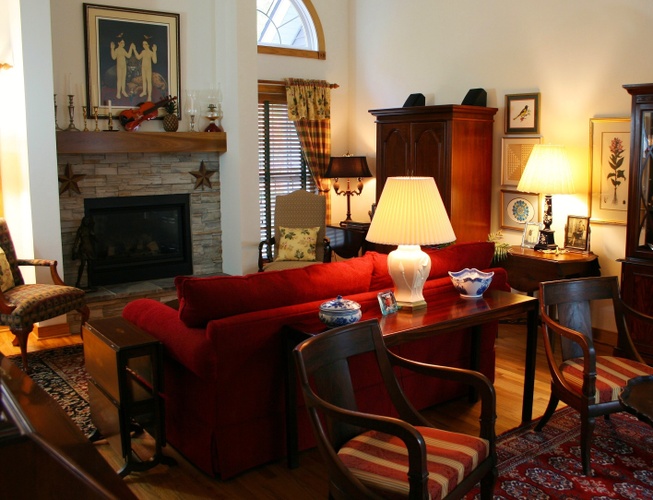
Hazards in the garage, attic, basement & outdoor spaces
Not all homes have garages, attics, basements. But if yours does, it’s important to make them as safe as possible. In most cases, it’s best to arrange the home so the senior does not have to access either the attic or the basement. This might require relocating laundry machines or setting up a laundry pick-up and delivery service. Work areas – especially those where power tools are used – can be especially dangerous for seniors. Sharp or pointed tools can make a fall significantly more hazardous. It’s important to make sure any workshop area is tidy and set back from main walkways. Outdoor areas can provide relaxation and enjoyment, but they can also be perilous if the ground is uneven or furniture degrades in the elements.
Garage
❏ Is the garage on the same level as the rest of the home?
❏ Is the surface level? Look for cracks in concrete.
❏ Does the garage have an automatic door opener?
❏ If you use a wheelchair, walker or other mobility aid, is there at least 5 feet of room between your vehicle and any other car or obstacle?
❏ Is the doorway into the house at least 3 feet wide?
❏ Is there an organized storage system to keep tools and other items out of walkways?
❏ If you have or might someday need a wheelchair lift van, does the garage door provide at least 9 feet of clearance?
❏ Do lights turn on automatically when you enter the garage?
Attic and Basement
❏ Are any essential items (ex. laundry) located in an attic or basement? If so, can they be relocated?
❏ Can the attic or basement be locked to prevent access?
❏ How steep are the stairs to the basement?
❏ Is there a handrail on both sides?
❏ Is the basement well lit?
❏ How is the attic accessed – by ladder or stairs?
❏ How steep is the roof slope? Is there room to stand upright?
❏ Are there nails, rough wood, poor air quality, or other hazards in the attic or basement?
Decks, patios, and yards
❏ Is the patio or deck close to the house?
❏ Are hard surfaces in good condition? Look for signs of weathering, cracking, or buckling.
❏ Is the terrain uneven or slippery?
❏ Are there any fall hazards like tree roots, cracked pavers, or holes?
❏ Are there handrails or sturdy furniture to grab for support?
❏ Is outdoor seating easy to access with wide aisles and no obstacles?
❏ Is outdoor furniture in good condition?
❏ Are patio cushions firm?
❏ Is there enough shade? Heat and dehydration can cause dizziness.
❏ If the deck or patio is used at night, is there ample lighting?
❏ Is the landscaping low-maintenance or handled by a professional?
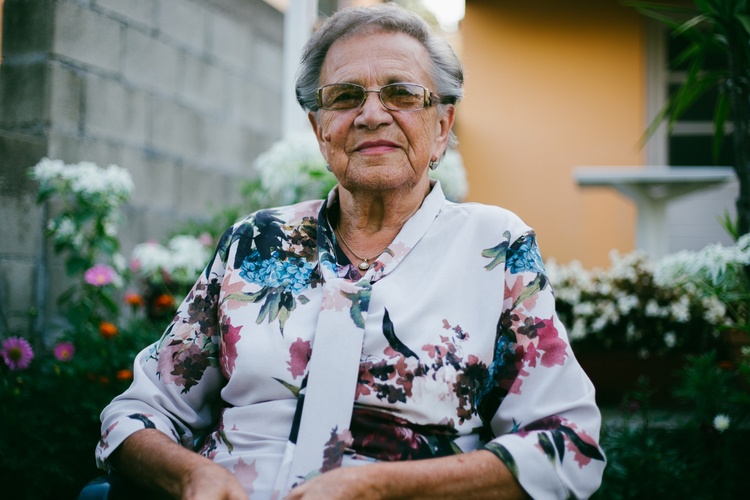
Should you modify your existing home or move?
Aging in place is appealing to many seniors – partly because of the high cost of retirement communities and long-term care, and partly because they love the homes where they raised their families and created cherished memories. For some, it becomes a choice between relocating or renovating their current homes. While it might not be possible to stay put forever, a combination of home modifications, technology, and services such as home meal delivery can help older adults prolong their independence in their current home. One study found home modifications reduced the risk of falls by 39% per year.
Many fall-prevention home modifications can add value to your home as well as boosting quality of life. However, a few might not be worth making from a resale standpoint. As one aging-in-place specialist explained, “The best aging in place solutions should blend seamlessly into the use of a space.” They should be tasteful and in keeping with the home’s architectural style. They shouldn’t make a home feel sterile or hospital-like.
Universal Design is a type of home construction that is safe and accessible for people of all ages and abilities, including those with disabilities. Studies have shown that Universal Design modifications generally increase a home's resale value. Some examples of Universal Design include:
● Good lighting
● Safe and accessible bathrooms
● Lever door and faucet handles
● Non-slip surfaces
● No steps at entrances
● A maximum ½-inch rise at thresholds
● Wide doorways
● Ground-floor master bedrooms, baths, and laundry
● Avoidance of glossy surfaces
Those features are widely considered appealing. On the other hand, additions that change the look of a home and make it stand out as "accessible," such as a large wheelchair ramps, could have a negative impact on resale. That doesn’t mean you shouldn’t do make the renovations. The fall-prevention benefit may far outweigh any real estate considerations. But here are a few things to consider:
● Walk-in showers might be better for resale value than walk-in tubs.
● You might want to remove grab bars and shower seats before putting your home on the market.
● If you are installing a wheelchair ramp, consider getting one that can go over existing steps and be removed for resale.
● Stair lifts can be really helpful, but there’s no easy way to disguise them or make them blend in. It might be best to remove them before selling your home.
Each homeowner has to weigh the pros and cons of modifying a home versus moving to one that is structurally better-suited to senior fall prevention. Renovations can be stressful.
Of course, at the end of the day, resale success depends on the buyer. With more Baby Boomers reaching retirement age each year, demand for accessible homes may rise. If you live in an area with a large number of disabled or senior individuals, you may see more value from fall-prevention modifications. For the best advice about all of these decisions, consult a licensed real estate agent.
